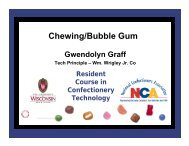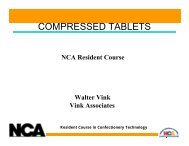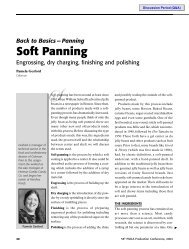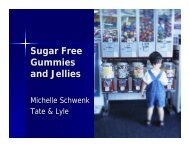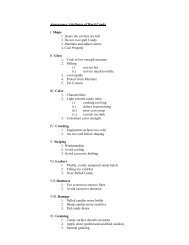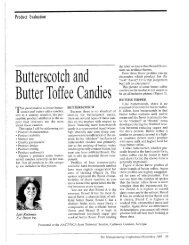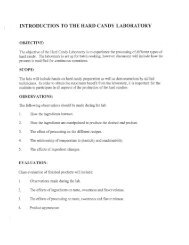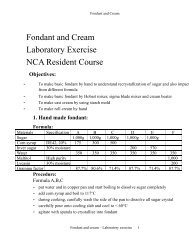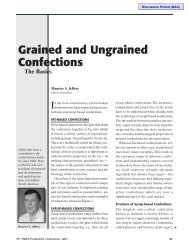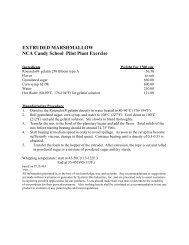2003 Caramel--Raw Materials and Formulations - staging.files.cms ...
2003 Caramel--Raw Materials and Formulations - staging.files.cms ...
2003 Caramel--Raw Materials and Formulations - staging.files.cms ...
Create successful ePaper yourself
Turn your PDF publications into a flip-book with our unique Google optimized e-Paper software.
<strong>Caramel</strong> — <strong>Raw</strong> <strong>Materials</strong> <strong>and</strong> <strong>Formulations</strong><br />
The characteristics<br />
of your finished<br />
product will then be<br />
the result of the<br />
properties of each<br />
phase <strong>and</strong> how both<br />
phases complement<br />
each other.<br />
than 1,000 lbs an hour? How long will it<br />
take to cook or cool to temperature? How<br />
much shear is involved? Are you depositing<br />
or extruding? How much graining, if<br />
any, do you need when forming? Is it to be<br />
held <strong>and</strong> used later as a component to a<br />
more elaborate confection? Then, what<br />
do you want to happen after packaging<br />
so it’s perfect when the consumer eats it?<br />
These are some of the questions you have<br />
to not only ask, but also to underst<strong>and</strong><br />
the answers.<br />
A CARAMEL RECIPE<br />
First, let’s describe caramel. Depending on<br />
who you ask, you can get a variety of<br />
answers.You’ll even get different pronunciations.<br />
Answers will range from a flowable<br />
ice cream topping to a glassy hard<br />
c<strong>and</strong>y. It can be part of a c<strong>and</strong>y bar as a<br />
layer to add texture <strong>and</strong> flavor, something<br />
that is sticky to hold peanuts or other inclusions<br />
in place, or one of the favorite fillings<br />
in a box chocolate, where it can be<br />
shaped with good st<strong>and</strong>-up for enrobing<br />
or flowable enough at cooler temperatures<br />
for shell-moulded c<strong>and</strong>y. The most recognizable<br />
form may be the brown cubeshaped,<br />
soft <strong>and</strong> creamy confection. But<br />
even this last description can vary; is it a<br />
chewy, long-textured, ungrained piece or<br />
is it a tender, short, grained one? Is it<br />
fudge? Once you’ve decided exactly what<br />
it is that you want to make <strong>and</strong> how it is to<br />
function, you can then begin to determine<br />
what your recipe will be <strong>and</strong> which raw<br />
materials to use.<br />
There are hundreds of recipes <strong>and</strong> such<br />
a wide range of raw materials available<br />
that it can become very confusing as to<br />
where to begin, let alone how to modify<br />
your recipe to get the exact product you<br />
want. There are some basic parameters<br />
often given, such as ratio of sucrose to corn<br />
syrup, level of milk proteins <strong>and</strong> so on, but<br />
to me that just limits your possibilities <strong>and</strong><br />
creativity. After all, if you want to make<br />
something different, you have to do it differently.<br />
It first comes down to knowing<br />
exactly what you want to make. You can<br />
start by looking at the variety of books <strong>and</strong><br />
articles (e.g., as in the Manufacturing Confectioner)<br />
that are available <strong>and</strong> start with<br />
one that comes closest to what you want in<br />
a caramel.You can even start with the label<br />
of an existing product.<br />
Underst<strong>and</strong>ing the Recipe<br />
Following the old adage that it is better to<br />
teach a person how to fish than to give him<br />
a fish, we will show you how to get a better<br />
underst<strong>and</strong>ing of your recipe <strong>and</strong> the raw<br />
materials <strong>and</strong> how to use that underst<strong>and</strong>ing<br />
to modify your recipe to best fit your<br />
process <strong>and</strong> give you that perfect caramel<br />
you want to make. So, rather than give<br />
parameters that may limit you, we’ll just<br />
start with a recipe we’ve found <strong>and</strong> learn<br />
what to do to underst<strong>and</strong> it so you can<br />
meaningfully change it as necessary.<br />
<strong>Caramel</strong> Recipe<br />
Water . . . . . . . . . . . . . . . . . . . . . . . . . . . 170.0 g<br />
Sugar, granulated . . . . . . . . . . . . . . . . . . 454.0 g<br />
Corn Syrup, 42de/a . . . . . . . . . . . . . . . . 369.0 g<br />
Sweetened condensed whole milk . . . . 312.0 g<br />
Partially hydrogenated vegetable fat . . . . 184.0 g<br />
Salt . . . . . . . . . . . . . . . . . . . . . . . . . . . . . . 14.0 g<br />
Soy lecithin . . . . . . . . . . . . . . . . . . . . . . . . . 2.5 g<br />
Figure 1<br />
This recipe (Figure 1) looks fine <strong>and</strong> is<br />
written just as you need it for batching in<br />
production. But it really doesn’t tell us<br />
what is in there. So to better underst<strong>and</strong> a<br />
recipe, change it into a formula. In other<br />
words, break it down so you know exactly<br />
what it is you’re working with.<br />
Let’s start going through the recipe<br />
ingredients <strong>and</strong> break them down where<br />
we can.Then we can discuss their purpose<br />
<strong>and</strong> see how together they make that particular<br />
caramel. For this paper, the num-<br />
24 57 th PMCA Production Conference, <strong>2003</strong><br />
➤



